Contents
Ostrich fern is often used in landscaping large areas, in landscape design and simply to decorate the space around the house. He feels great in the open field, without requiring special care and special conditions.
What does an ostrich feather fern look like?
Ostrich feather fern is a perennial herbaceous plant, reaching up to 1,5-2 m in height and more than 1 m in diameter. The root processes of the ostrich are long, creeping, brown-black in color with scales on the surface.
Fern branches are arranged in a circle from the rhizome. Thanks to their simultaneous growth, the plant forms an even, beautiful shape. Vayi outwardly resemble ostrich feathers, thanks to which this variety of fern got its corresponding name.

Branches are of two types – barren and spore-bearing. The former can reach 2 m in height and about 20 cm in width, have a bright green color and a pinnately dissected structure.
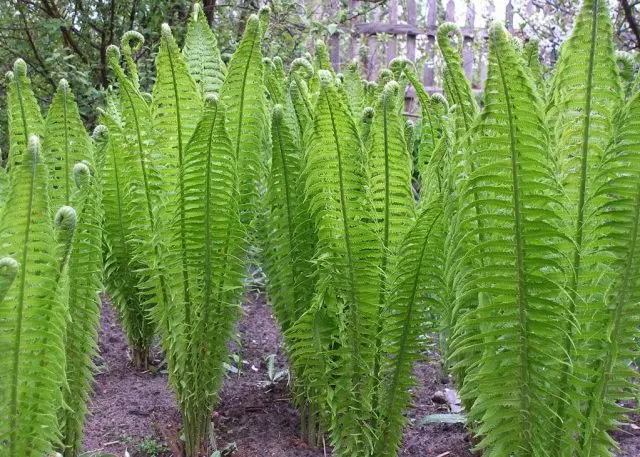
It is they who form the external high funnel-ring, in the center of which, by the middle of summer, low (about half a meter), dense fronds with a darkish color, bearing sporangia, develop. These branches have a much smaller number of leaves, compared to barren ones, but at the same time they can remain on the bush for several years without falling off in winter.
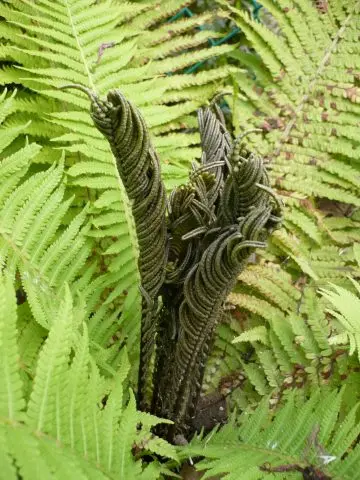
Under natural conditions, the ostrich feather fern can be found in mixed forests with high humidity, as well as in close proximity to water bodies. It is widely distributed in the European part of Our Country, in the Far East, Ukraine.

Types of ostrich
In the biological description of the fern, the ostrich is usually distinguished into 2 main species: ordinary and oriental. Outwardly, both varieties are very similar, but they also have some distinctive features.
Oriental
Oriental ostrich or Matteuccia orientalis can be found on the territory of the Sakhalin region, Korea or China. In its structure, it is similar to an ordinary fern – high strong branches of the first order and spore-bearing brown fronds in the center. But the eastern ostrich is not as tall as its relative – on average no more than 1,3 m, it has fewer leaves, while the size of the leaves themselves is somewhat larger.
An important difference of the species is that it tolerates adverse environmental conditions worse. The plant needs regular watering and protection from drafts and frost. Spore-bearing fronds die off for the winter.

Ordinary
The common ostrich fern is distinguished by its high endurance and unpretentiousness. It develops quite quickly, tolerates frost well and does not require constant care. The only requirement for its growth is sufficient and regular watering.
The area of its distribution is quite extensive, due to the fact that the plant feels great on almost any soil and in various climatic conditions.
The common ostrich has powerful high fronds of rich green color and a powerful root system. It is this variety that is used to decorate garden plots and landscaping areas.
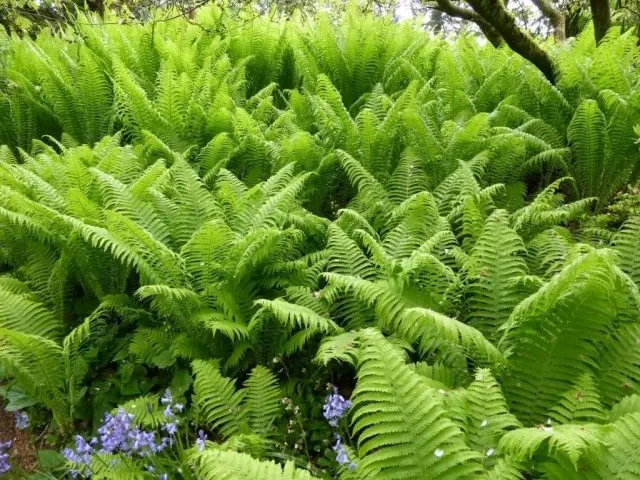
How does the ostrich feather fern reproduce?
Ferns are among the oldest plants that arose even before the appearance of bees. It is with this that the absence of flowers in this plant is connected – it does not need pollination and seed development.
There are 2 ways to propagate ferns:
- Vegetative – by separating a part of the root with sprouts and buds.
- By means of dispute. Spores develop on fronds located in the center of the rosette. They are collected at the end of summer and planted in a small closed container, regularly watering and airing. After 1-2 years, when the sprouts get stronger, they can be planted directly on the site.
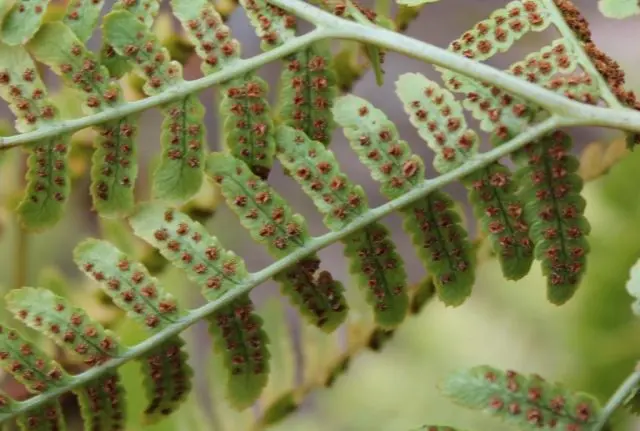
Planting and caring for an ostrich fern
Planting an ostrich fern and subsequent care of the plant is not difficult. Subject to simple rules, the plant will feel great in almost any area and delight with fluffy green leaves.
Terms of planting
Planting shoots with a vegetative method of reproduction is carried out either in the first spring months before the leaves appear, or at the end of summer, when sporulation occurs.
If the ostrich fern is propagated from spores, then the strengthened plants are transferred to the open ground in the spring, when the weather is warm.
Site selection and preparation of soil
Both a shaded area and a well-lit place are suitable for growing ferns. It should be borne in mind that with a large amount of sunlight, one should not count on a strong growth of shoots (their height in this case will not exceed 1 m) and a rich color of the leaves. The most juicy color is acquired by the leaves of the ostrich growing in shaded places with high humidity.
When choosing a site, you need to pay attention to the fact that the root system of the plant grows very quickly and in a year it may be at a distance of several meters from the main bush.
As for the soil, sandy dry soil would not be the best option. Such soil will have to be watered frequently to create comfortable conditions for plant growth. Otherwise, the fern has no requirements for the composition of the soil. It can fully develop both on fertile and infertile lands, as well as on soils with any acidity.
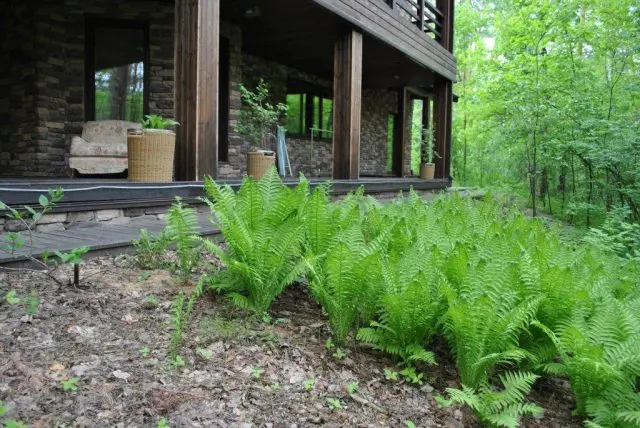
How to plant
The rules for planting an ostrich depend on which breeding method is chosen. With the vegetative method, a part of the rhizome 20-30 cm long is taken. In this case, there must be at least 2 buds on the process. It is planted to a depth of about 5 cm at a distance of at least 50 cm from other ferns.
Growing an ostrich from spores is a laborious but more efficient process. Spores are collected in August and planted in a disinfected peat mixture. At the same time, the collected spores do not have to be planted immediately, they can be stored for several years. The container with planted spores is covered with a strong transparent lid and left for a while, not forgetting to ventilate and water regularly.
After a few weeks, when the spores germinate, the lid can be removed. The grown fern is dived and seated in separate containers. At home, seedlings are grown for at least 2 years and only then they are taken out to the site.
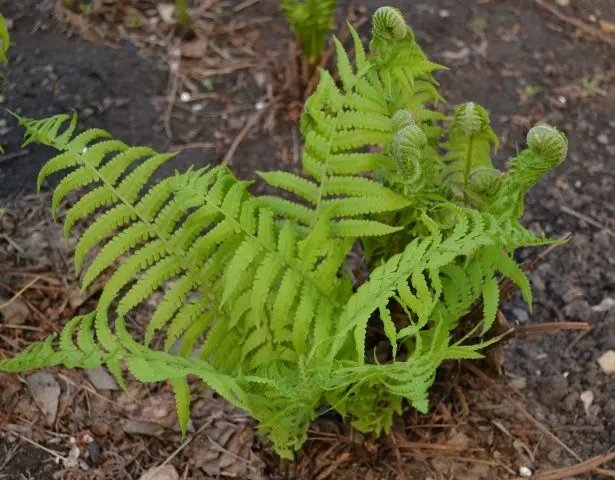
It is better to plant a fern in groups of 5-6 pieces at a distance of at least 40-80 cm from each other. For planting, it is recommended to use a scheme similar to the natural growth conditions of an ostrich, with triangles. Such a planting will ensure the subsequent independent vegetative reproduction of the fern.
Care instructions
Ostrich is a plant that does not require significant care. If the site as a whole meets the needs of the plant, then with minimal care it will delight the eye with lush green bushes.
Watering
Sufficient humidity is perhaps the only mandatory requirement when growing an ostrich feather. The plant needs regular moderate watering. If the soil is very dry or the weather is hot, then the fern must be watered abundantly, and the aerial part should also be sprayed with the rain method.
Additional fertilizing
Straussoper does not feel the need for additional fertilizers. However, some gardeners report a good response to the occasional use of organic and mineral supplements.
Pruning, shelter for the winter
The plant does not need pruning. Instead, once every 3-4 years, the ostrich needs to be thinned out, as it grows quite quickly. To prevent the appearance of fern thickets, it is necessary to remove excess shoots.

The ostrich feather tolerates low temperatures well, so it usually does not require any preparation for winter. If the winter is expected to be very cold, then covering materials can be used.
Application in landscape design
The main application of the ostrich-oper is the use of individual plots or park areas in landscape design. The photo shows that an ostrich feather fern can be an ornament to almost any composition. It can be planted among stones and boulders or on the banks of water bodies.

The ostrich coexists well with tall large flowers, like irises or peonies.
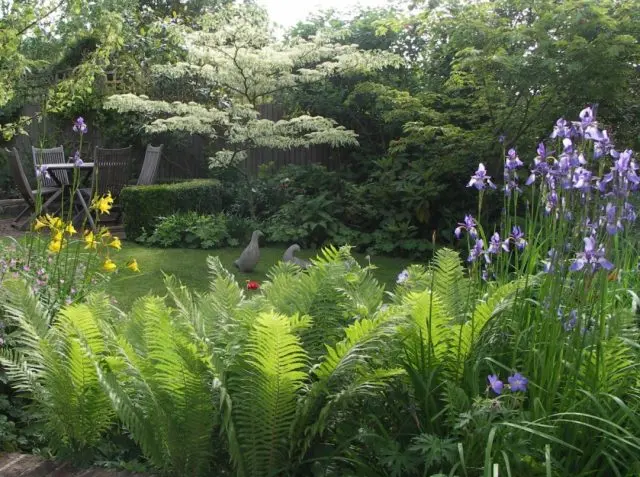
When grown in shady areas, the ostrich can keep company with hostas or daylilies.

Often you can find a fern next to early spring flowers – tulips and daffodils, growing, the ostrich closes already faded plants.

As for the undesirable neighborhood, it is not recommended to plant a fern next to light-loving low flowers (zinnias, petunias, marigolds), since the ostrich will block the planting from the sun’s rays. It should also be remembered that the plant has a highly developed, rapidly growing rhizome, which can crush weaker neighbors.

Diseases and pests
Another undoubted plus of the ostrich fern is its high resistance to various diseases, as well as the effects of insect pests.
The only danger is the thickening of the plantings, combined with high humidity. Under such conditions, fungal infection is possible. It appears as dark spots on the leaves. When detected, the affected shoots must be removed and destroyed, and the remaining plants should be sprayed with a fungicide.
Conclusion
Ostrich fern is a very beautiful and unpretentious plant that can decorate any site or territory. Growing an ostrich on your own will not be difficult, even a novice gardener can do it. The plant has lush bright green leaves and goes well with most garden flowers.









